Printer Not Printing
Encountering a printer not printing can be an immense frustration, especially when urgent documents are needed. Whether it’s essential work reports or personal projects, when your printer won’t print, it disrupts both home and office productivity. This common setback happens too often and usually at the most inconvenient times.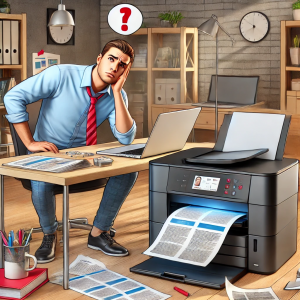
In both domestic and corporate settings, a fully functional printer is vital. At home, it facilitates educational tasks and personal endeavors, while in the office, it is crucial for maintaining business operations and effective communication. The implications of a printer connected but not printing are significant—resulting in decreased productivity and increased stress.
Recognizing the importance of routine maintenance and periodic checks is crucial for minimizing the frequency of printer not printing issues. Nonetheless, even with diligent care, problems like a wireless printer not printing or the printer not printing properly can still arise.
This blog aims to assist you in diagnosing and resolving printer not printing challenges. Whether you’re facing a printer that won’t print or encountering issues with a printer connected but not printing, our blog offers comprehensive troubleshooting steps. We provide clear, actionable solutions to help you quickly fix your printer not printing dilemmas and restore its functionality, making sure minimal disruption to your daily activities. Let’s explore the typical causes and effective fixes to get your printing needs back on track.
Preliminary Checks for Printer Not Printing
When you encounter issues with your printer not printing or it seems to be malfunctioning, it’s essential to start with some basic checks. This section provides detailed steps to evaluate printer status, connection integrity, and correct setup.
Check Printer Status and Error Messages
Understanding your printer’s communication through status lights and error messages is crucial for troubleshooting.
-
LED Status Lights:
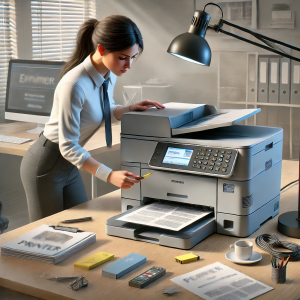 Check the LED status indicators, which can alert you to various states such as power, errors, and low supplies. A constant light usually indicates normal operations, whereas a flashing light might suggest an error that could prevent your printer from printing. Your printer’s manual will have specific details for interpreting these lights.
Check the LED status indicators, which can alert you to various states such as power, errors, and low supplies. A constant light usually indicates normal operations, whereas a flashing light might suggest an error that could prevent your printer from printing. Your printer’s manual will have specific details for interpreting these lights. -
Error Messages:
If your printer is not printing properly, you might see error messages either on the printer’s display or within the computer’s printer management software. These messages can range from “Paper Jam” to “Low Ink” or specific error codes. These are critical clues that can explain why you face printer not printing issue.
-
Printer Software and Dialogue Box Alerts:
Use your printer’s software interface on your computer for detailed diagnostics, especially useful when a wireless printer is not printing. This utility can provide advanced troubleshooting options for resolving connectivity and configuration issues.
Verify Printer Connection
-
USB and Ethernet Connections:
Ensure that all cables are firmly connected and undamaged to avoid a printer not printing scenario. Check both the printer side and the connecting device side. A faulty or loose connection is often the culprit behind a printer connected but not printing.
-
Wireless Connectivity:
For a wireless printer connected but not printing, confirm that your printer is linked to the right wireless network. Resetting your router and printer can help re-establish a lost connection. Look into potential signal disruptions or obstructions that might affect wireless communication.
-
Connection Troubleshooting:
If everything seems connected but your printer not printing properly, examine network settings like IP addresses and firewall configurations. Sometimes, these settings can interfere with your printer’s ability to communicate with your network, leading to a troubleshoot printer not printing situation.
Ensure Correct Printer Setup
-
Installation Accuracy:
Incorrect software installation can lead to a printer not printing. Make sure that all necessary printer software, including drivers and utilities, is installed correctly and is up to date to avoid a printer won’t print issue.
-
Default Printer Configuration:
Check if your printer is set as the default device in your system settings. A non-default printer might cause a printer not printing properly issue when commands are sent to the wrong device.
-
Printer Preferences Review:
Improperly configured printer preferences can also result in a printer not printing properly. Double-check that settings like paper size and print quality are appropriately adjusted for your printing needs.
Through these detailed preliminary checks, you’ll be well-equipped to identify and fix basic problems that could be causing your printer not printing issues, ensuring your device operates smoothly and efficiently. If you want to know how to correctlt set up printer and resolve issues related to it, you can read our detailed blog on Printer Setup.
Basic Troubleshooting Steps for Printer Not Printing Issue
When your printer not printing issue occurs or if you encounter any operational hiccups, following these basic troubleshooting steps can resolve the issue without the need for professional help. This section covers restarting your devices, resolving paper feed issues, and checking ink or toner levels.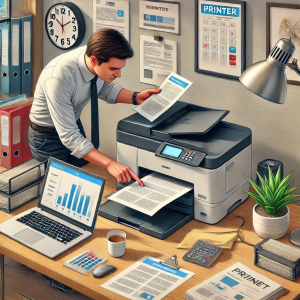
Restart Your Printer and Computer
A simple restart can often resolve printing issues, acting as a reset for any error states within the devices.
-
Turn Off Your Printer:
Power down your printer by pressing the power button. If your printer won’t print due to software or communication errors, this step can clear those errors effectively.
-
Restart Your Computer:
Sometimes the issue lies not with the printer but with the computer sending the print jobs. Restarting your computer can resolve hidden issues that cause the printer not printing properly.
-
Power on Your Printer and Computer:
After waiting for about 30 seconds, turn both your printer and computer back on. This allows all systems to refresh, potentially fixing any printer not printing issues.
-
Test Printing:
Send a print command to see if restarting both devices resolved the printer not printing problem. This simple step can frequently save time and effort from more complex troubleshooting.
Check for Printer Paper Issues
Paper feed problems are common and can cause your printer not printing properly.
-
Check Paper Tray:
Ensure the paper tray is loaded correctly and isn’t overloaded or underloaded. Incorrect paper loading can lead to jams which prevent your printer from printing.
-
Remove Paper Jams:
Open the printer carefully following the manufacturer’s instructions and remove any stuck paper. Be gentle to avoid tearing the paper and leaving bits behind that could cause further issues.
-
Adjust Paper Guides:
The guides in the paper tray should be snug but not too tight. They help guide the paper correctly through the printer, ensuring smooth printing without any issues.
-
Test with Different Paper:
Sometimes, the issue might be with the paper quality or type. If your wireless printer is linked but not printing, try changing the paper to see if that resolves the issue.
Check Ink or Toner Levels
Low ink or toner can result in poor print quality or no printing at all.
-
Check Levels via Printer Menu:
Most modern printers enable you to check ink or toner levels directly on their display menus. Navigate through the menu to find the ink or toner status.
-
Software Check:
You can also check ink or toner levels through the printer software installed on your computer. This is especially helpful if your printer is not printing properly and you suspect ink or toner levels might be the cause.
-
Replace Ink or Toner Cartridges:
If the levels are low, replace the cartridges according to the manufacturer’s instructions. Make sure you’re using the correct type and size of ink or toner for your specific model to avoid further printer not printing properly issues.
These fundamental troubleshooting techniques will help you deal with typical problems that might cause your printer not printing problems. These steps are designed to be easy and quick, helping you get back to printing without significant downtime.
Advanced Troubleshooting Techniques for Printer Not Printing Issue
When basic troubleshooting does not resolve your printer not printing issues, advanced techniques may be necessary. This section delves into updating printer drivers and software, clearing the printer queue, and configuring printer settings for optimal performance.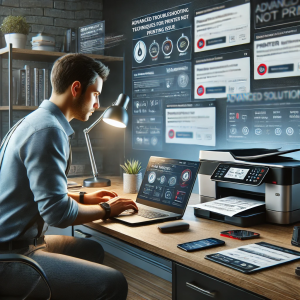
Update Printer Drivers and Software
Keeping your printer drivers and software up-to-date is crucial for ensuring compatibility and functionality.
-
Importance of Updated Drivers:
Updated drivers often include patches for known bugs and improvements that can enhance printer performance and reliability. This is especially important if your printer is not printing properly and could be due to outdated software.
-
Finding the Latest Drivers:
Visit the printer manufacturer’s website and go to their ‘Support’ or ‘Downloads’ section. Here, you can find the latest drivers for your model. Be sure to choose the correct version that matches your computer’s operating system to avoid further printer won’t print issues.
-
Installing Drivers:
Download the driver and follow the installation instructions provided. This may involve executing a setup file or updating through your printer’s software interface on your computer. This step is vital to troubleshoot printer not printing problems effectively.
Clear Printer Queue
A clogged printer queue with stuck print jobs can prevent your printer from functioning correctly.
-
Accessing the Print Queue:
On your computer, open the control panel and go to ‘Devices and Printers’ (Windows) or ‘Printers & Scanners’ (Mac). Right-click your printer icon and select ‘See what’s printing’ to open the print queue.
-
Clearing the Queue:
If there are stuck jobs, you can select each and choose ‘Cancel’ to clear them out. This is a common solution for a printer not printing properly due to backlog issues.
-
Restarting the Printer:
After clearing the queue, restart your printer to refresh its internal memory and eliminate any residual errors that might cause the printer not printing issue.
Configure Printer Settings
Properly configuring your printer settings can resolve issues related to performance and connectivity, especially when a wireless printer not printing.
-
Accessing Printer Settings:
You can access settings through the printer’s display panel or via its software on the computer. This is crucial for adjusting settings that might be preventing your printer from operating correctly.
-
Adjusting Quality and Paper Settings:
Ensure that settings such as paper size, paper type, and print quality are correctly configured to match your specific printing needs. Misconfigured settings can often lead to a printer not printing properly.
-
Network and Connectivity Settings:
For wireless printers, ensure that network settings like the IP address, subnet mask, and gateway are correct. Misconfigurations here can lead to issues where your wireless printer not printing.
By applying these advanced troubleshooting techniques, you can address and resolve more complex issues that prevent your printer from operating as expected. These steps are designed to tackle problems that go beyond simple fixes, offering solutions to more persistent challenge of printer not printing properly.
Preventive Measures for Printer Not Printing Issue
Maintaining a printer is often overlooked until the moment it malfunctions. Regularly attending to your printer can greatly reduce instances where your printer won’t print or where you find your wireless printer not printing despite appearing connected. In this section, we’ll discuss the importance of regular maintenance, keeping your software up-to-date, and adopting best practices for using your printer.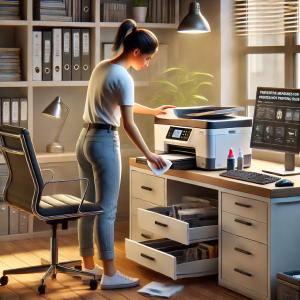
Regular Maintenance
Regular maintenance is crucial in preventing situations where your printer not printing properly. Simple steps like cleaning the printer heads, checking for software updates, and replacing old or worn-out parts can make a great difference in performance. This is particularly important in office settings where the volume of tasks that depend on printers is usually high.
Cleaning should involve removing any dust, paper fiber, or ink residue that could potentially clog the printer heads. Also, ensuring that the paper tray is free from small bits of torn paper can prevent paper jams. Regular checks for these small issues can help keep the common printer connected but not printing issue at bay.
Software and Firmware Updates
Staying updated with the latest printer software and firmware is a key step in ensuring your printer functions as expected. Manufacturers release updates regularly to fix bugs, improve performance, and add new features. These updates can resolve underlying problems that might cause your printer not printing properly or the wireless printer not printing.
To look for updates, you can visit the manufacturer’s website or enable automatic updates in the printer’s settings. This proactive approach not only enhances functionality but also secures your printer from potential security vulnerabilities—a critical aspect especially for network-connected and wireless printers.
Best Practices for Printer Use
Adopting best practices in using your printer can extend its lifespan and minimize common problems like printer won’t print or needing to troubleshoot printer not printing issues frequently. Here are a few tips:
-
Use the right paper type:
Always use the type of paper suitable for your printer. Using incorrect paper can cause paper jams and affect print quality.
-
Avoid overloading the paper tray:
This is a common cause for paper jams. Ensure the paper tray is not stuffed beyond its capacity.
-
Turn off the printer when not in use:
This can prevent overheating and save energy. However, do not turn it on and off too frequently as the warming up process also uses a considerable amount of ink.
-
Regularly use your printer:
If the printer is not used regularly, ink may dry up and clog the print heads. Even printing a few pages a week can keep the ink flowing and prevent clogs.
By following these maintenance tips and best practices, you can prevent most issues related to printer not printing properly and ensure that your printer remains reliable, efficient, and ready to handle your printing needs. This preventive approach saves both time and money by reducing the frequency of malfunctions and the need for repairs.
FAQs
Q1. What should I do first if my printer won’t print?
- A. Begin by checking if your printer is powered on and connected. If your printer won’t print, verify both the physical connections and the status on your computer or network to ensure it’s recognized.
Q2. Why is my printer connected but not printing?
- A. If you face the issue of printer connected but not printing, check for simple issues like a paper jam or empty ink cartridges. Also, ensure the printer software is set up correctly and that the printer is set as the default printing device.
Q3. How can I resolve a wireless printer not printing?
- A. For a wireless printer not printing, first check your Wi-Fi connection and printer’s network settings. Restarting your router and printer can often re-establish lost connections.
Q4. What steps to take to troubleshoot printer not printing issues?
- A. To troubleshoot printer not printing, start by checking error messages and the printer queue. Updating drivers, checking connections, and ensuring there are no hardware faults are also crucial steps.
Q5. Why does my printer not print properly even though it has ink?
- A. If your printer not printing properly, it could be due to blocked print heads or wrong paper type. Running a cleaning cycle and aligning the print head might resolve this issue.
Q6. What should I do if my wireless printer is connected but not printing?
- A. If your wireless printer connected but not printing, check for signal interference or security settings blocking communication. Ensure that your printer is within a good range of your wireless router.
Q7. How do I fix a printer that’s showing as online but won’t print?
- A. If your printer appears online but printer won’t print, clear any stuck print jobs in the queue. Restart your printer and computer to reset their connection to the network.
Q8. What regular maintenance should I perform to prevent printer not printing issues?
- A. Regularly clean your printer, update its firmware, and check for any physical wear and tear. This can help prevent issues where the printer not printing occurs.
Q9. How can I identify if my printer not printing is due to a hardware issue?
- A. If you’ve tried all troubleshooting steps and your printer not printing, inspect the printer for any visible damage or unusual noises. Professional help might be required if hardware failure is suspected.
Q10. When should I seek professional help for my printer not printing properly?
- A. If basic troubleshooting, such as checking connections and running maintenance tasks, doesn’t fix your printer not printing properly, it’s time to consult with a technician, especially if you suspect internal damage or software issues.
Conclusion
Throughout this blog, we’ve explored a variety of steps to help you when your printer won’t print. From preliminary checks to detailed troubleshooting techniques, the objective has been to empower you with the knowledge to address the common yet frustrating issue of a printer not printing properly.
We’ve covered everything from ensuring that your printer connected but not printing issues are resolved by verifying physical and wireless connections, to more complex scenarios where updates or settings adjustments are necessary. The steps outlined here are designed to guide you through the process of diagnosing and resolving the typical wireless printer not printing dilemmas, using systematic and easy-to-follow methods.
While it is advantageous to handle common printer issues on your own, recognizing when to call in a professional is equally important. If after following all the suggested steps, your printer not printing properly, it might indicate a more serious problem that requires expert attention. Don’t hesitate to contact the support number mentioned on our Homepage if the problem persists. Sometimes, professional intervention is the most time-efficient and cost-effective way to get back to smooth operations.
Together, let’s keep our printers in peak condition and minimize those all-too-common scenarios where we encounter a printer not printing properly. Your insights not only enrich this resource but also build a community of informed and proactive users.
